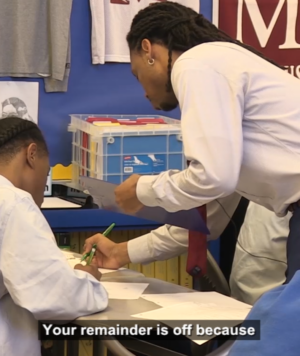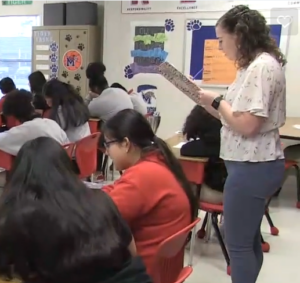01.03.24Working Memory, Teachers and Tracking Data
Posted a quick note on Twitter the other day about working memory and teachers- how using a clip board to note observations could allow teachers to free their working memory and thus be more responsive to students as they interacted. Having an exemplar–an ideal student answer you’d like to get to–written out and carried around with you, for example, could allow you to refer to it as needed and so not have to try to hold it in your working memory as you spoke to students. Again you’d have more working memory free to interact and remember important things that you observed.
I thought I’d post some examples from actual classrooms to show that I mean.
In this video Denarius Frazier circulates as his students divide polynomials.
He’s taking notes as they work so he is able to form a key observation from data that incrementally accumulates: finding the remainder is the main problem for his students. His intervention at the end is based on this accumulation of data, but all the while as he tracks it he is able to interact with each student in an authentic and responsive way as he walks around.
This is due in large in part to the fact that he is not trying to also remember who struggled with what. He is actually building a histogram of student errors as we works the room, but you’d never know it because when he’s not building it he’s not thinking about it! The point is only in part that his clipboard helps him to remember. It also allows him not not have to focus on trying to remember. He can be fully present with students. Without the clipboard he might remember that remainders were the issue. But his interactions with students and perceptions about their work wouldn’t be nearly as good. Or he could interact with students. But he’d probably lose the observation.
He also has an exemplar on his clipboard. You can see him use it to refresh his working memory at 1:12 in the clip.

Denarius glancing at his exemplar to refresh his working memory.
Again this allows him to give this student a key piece of feedback without trying to remember the steps to the answer himself as he works the room. He can focus on her answer.
His students feel the connection and his faith in them because he is fully present. But he’s also gathered a ton of data: that 8 or so students need to review how to find the remainder; that the right person to Show Call is Fagan; that Quinetta has an interesting alternative solution.
The science behind this is overwhelmingly clear. You simply cannot attend to everything you’d like to attend to when you are teaching. Your working memory is always under pressure. Taking “mental notes” is an illusion. In an environment this complex–thirty students, two problems, four or five steps each–there is no such thing as taking mental notes. You simply cannot remember it all and trying to do so will only cause you to do other important things poorly. The clipboard augments a teacher’s working memory. Doubly so if, as Denarius has done, it includes likely errors and a description of the ideal answer.
You can see those themes at work in this video of Erin Magliozzi. Circulating, she notes on her clipboard two students whom she wants to call on (Corey and Jackie) and why. “Jackie,” she says, “I’m going to ask you to share that difference.” Five minutes later she remembers exactly what was great about her answer and makes her feel great about it.
There are several minutes of lovely interactions between her and students between the time she makes these observations and when she seamlessly calls on them, easily weaving what was useful and important in their answers into her narrative as she calls on them. There’s just no way she could make them feel so seen and valued in that moment–and done the same with all the kids in between–if she was trying to hold those details in her working memory the whole time.

“Jackie, I’m going to ask you to share that difference.”
One teacher on Twitter asked in response: “So I’ll be more present if I am writing on a clipboard while circulating?” Maybe she was being sarcastic. Maybe not. But the answer is: Yes, you probably will.
If you’re interested in reading more, I discuss the power of these tools to address the constant challenge of teacher working memory overloads in TLAC 3.0, in the sections on Exemplar Planning (technique 1); Planning for Error (technique 2) and Active Observation (technique 9).
A colleague recently posted a photo of the clipboards he’d bought for all of his teachers to support them in observing more effectively and helping them to be more responsive to students. The cynics had a lot of fun with that. “Clipboards? Am I missing something?” one responded. The answer to that is: Yes, you most definitely are.